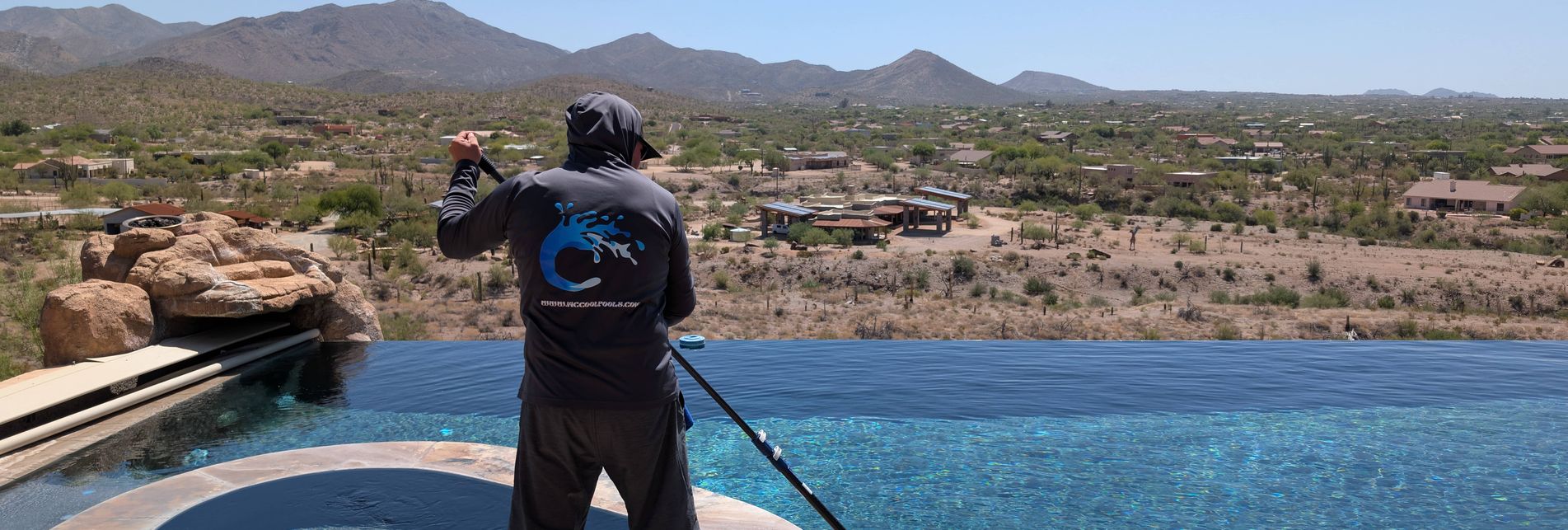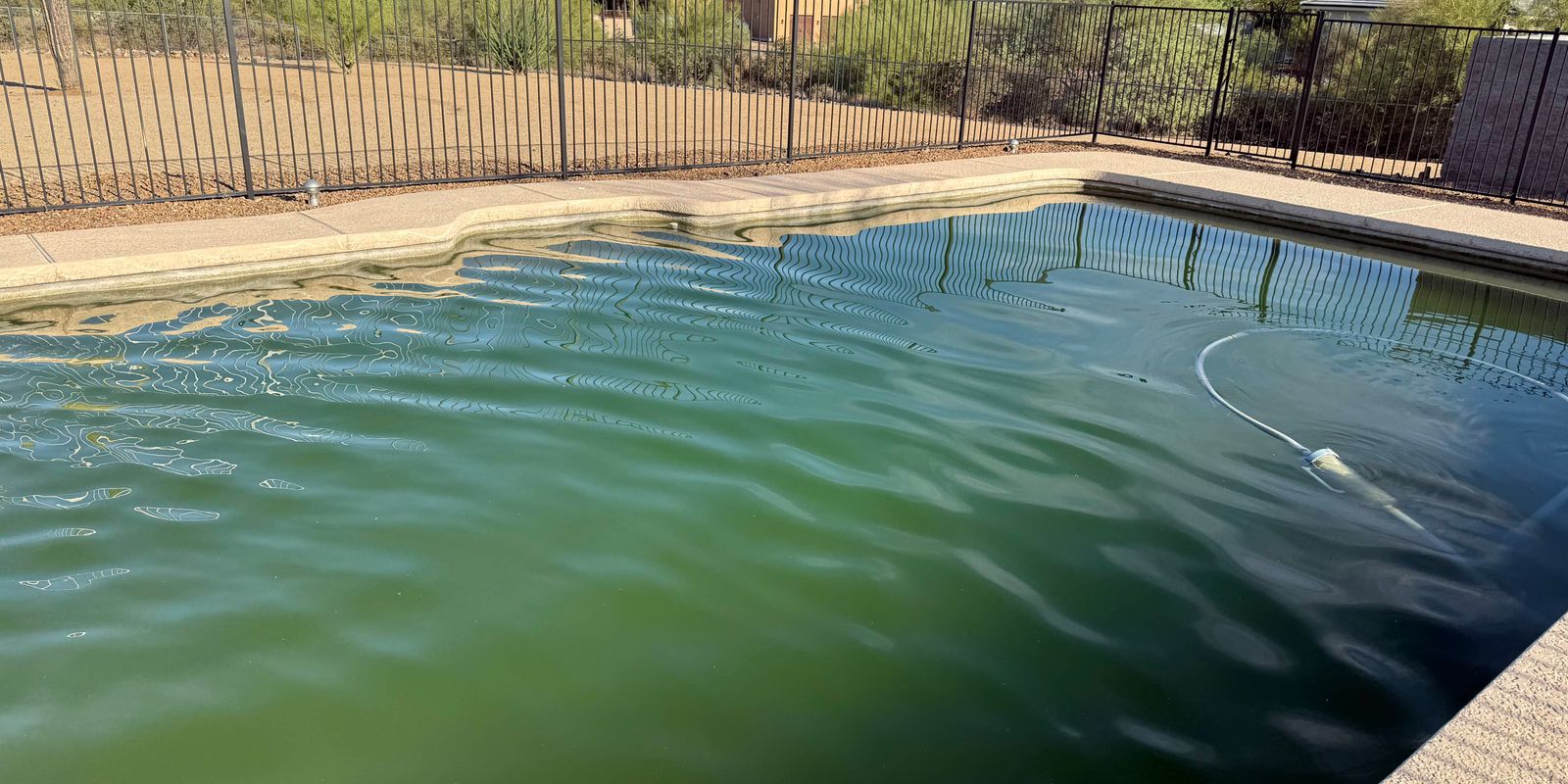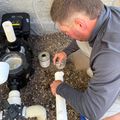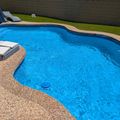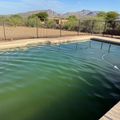That Green Pool is More Than Just Embarrassing
You've seen them in your neighborhood—pools that have turned from inviting blue to murky, algae-filled green. Maybe it's happened to you after a vacation, equipment failure, or lapse in service. While a green pool is certainly unappealing and unusable, the real problems go far deeper than aesthetics. That green water represents threats to your pool's surfaces, equipment, and plumbing that can cost thousands to repair if not addressed properly and promptly.
At McCool's Pools, we've cleared hundreds of green pools throughout the Phoenix area over nearly two decades. We've also witnessed the damage that develops when green pools aren't treated properly or sit too long before remediation. Understanding why pools turn green, what's really happening in that murky water, and how to both clear and prevent algae blooms protects your investment and keeps your pool healthy long-term.
Why Pools Turn Green (And Why It Happens Fast in Arizona)
Pool water turns green when algae—microscopic plant organisms that exist everywhere in our environment—find favorable conditions to multiply rapidly. Several factors trigger algae blooms:
Insufficient Chlorine Levels
The most common cause of green pools is inadequate sanitizer. Chlorine kills algae on contact, but when levels drop below effective concentrations (1-3 ppm for pools), algae multiply unchecked. In Phoenix's intense heat and sunlight, chlorine degrades rapidly—UV radiation breaks down chlorine molecules, and higher water temperatures accelerate this process. A pool that maintained proper chlorine levels in April might become a green swamp in July if the chlorination routine doesn't adjust for summer conditions.
Poor Water Circulation
Algae thrives in still water. When circulation systems don't run long enough or when areas of the pool receive inadequate flow (behind ladders, in spa spillways, around steps), algae establishes colonies in these "dead zones" and spreads from there. This is why pumps that fail during vacations or timer malfunctions often result in green pools within days.
Improper Water Balance
While chlorine is the primary algae killer, other water chemistry parameters affect algae growth. High pH reduces chlorine effectiveness dramatically—at pH 8.0, chlorine is only about 20% as effective as at pH 7.2. High phosphate levels (common in Phoenix) provide algae with nutrients for explosive growth. Inadequate cyanuric acid (chlorine stabilizer) in Arizona allows sunlight to destroy chlorine too quickly.
Equipment Failures
Malfunctioning salt systems, broken chlorine feeders, failed pump motors, or clogged filters can allow algae to take hold within 48-72 hours in summer heat. Equipment problems often go unnoticed until the water has already turned.
Service Lapses
Missing even one week of professional service during summer can allow algae blooms in Phoenix's extreme conditions. DIY pool owners who skip testing or chemical applications face even higher risks.
The Real Damage Green Pools Cause
Many pool owners think clearing a green pool is simply a matter of adding lots of chlorine and waiting. While chemical treatment is certainly involved, the problems green pools create often persist long after the water clears:
Algae Staining
Certain algae types—particularly black algae and mustard algae—penetrate porous pool surfaces like plaster, marcite, and pebble finishes. Even after killing the algae, dark stains remain embedded in the surface. These stains are difficult or impossible to remove without aggressive acid washing or even replastering in severe cases. A green pool that sits for weeks before treatment often develops permanent staining costing thousands to remediate.
Filter Damage and Clogging
Treating a green pool generates enormous amounts of dead algae that must be filtered out. This algae debris clogs filter media—cartridges become loaded, DE grids coat with organic matter, and sand filters channel and lose efficiency. Attempting to clear a green pool without proper filter cleaning or replacement often results in inadequate filtration and recurring algae problems. We've seen pool owners damage expensive cartridge filters by trying to clear green pools without professional guidance.
Metal Staining
Many pool owners attempt to clear green pools using copper-based algaecides. While these products kill algae, they often cause worse problems—copper precipitates out of solution in alkaline water (common in Phoenix) and creates permanent blue-green or black stains on pool surfaces. These metal stains require specialized treatments to remove and sometimes cannot be fully eliminated.
Plumbing Biofilm
Algae doesn't just grow in visible pool water—it colonizes plumbing lines, creating biofilm that persists even after the pool water clears. This biofilm continuously reseeds the pool with algae, making it nearly impossible to maintain clear water until the plumbing is properly treated. Standard shock treatments don't reach biofilm in pipes, requiring specialized procedures for complete elimination.
Equipment Corrosion
The high chemical doses required to clear green pools—often 10-20 times normal chlorine levels—stress equipment. Pump seals, heater heat exchangers, and metal fixtures corrode faster under extreme chemical conditions. While this treatment is necessary, it illustrates why prevention is far better than cure.
The Professional Green-to-Clear Process
Properly clearing a green pool requires systematic treatment that kills algae, removes debris, prevents staining, and eliminates biofilm:
1. Assessment and Testing
Professional treatment begins with evaluating algae type and severity. Black algae requires more aggressive treatment than green algae. Water chemistry is tested to identify underlying problems that allowed the bloom. Metal content is checked to prevent staining during treatment.
2. Brushing and Chemical Treatment
All pool surfaces are thoroughly brushed to break up algae colonies and suspend them in water where chemicals can work. Massive chlorine doses are applied—typically shocking the pool to 30+ ppm. Algaecides may be used, but professionals avoid copper-based products in hard water to prevent metal staining.
3. Continuous Circulation and Filtration
Pumps run continuously during treatment to circulate chemicals and filter dead algae. Filter cleaning happens multiple times as media becomes loaded with debris. Cartridges often require replacement after severe green pool treatment.
4. Vacuuming to Waste
Dead algae settles to the pool floor and must be vacuumed to waste (bypassing the filter) to prevent overloading filter media and reintroducing algae to the pool. This step wastes significant water but is essential for complete clearance.
5. Sequential Testing and Re-Treatment
Water is tested repeatedly as chlorine levels drop from killing algae. Additional shock treatments are applied as needed—often requiring several days of repeated chlorination to completely eliminate all algae and biofilm.
6. Water Balance Restoration
After algae elimination, water chemistry is carefully rebalanced to normal operating ranges. This includes adjusting pH, alkalinity, calcium hardness, and stabilizer to levels that prevent future blooms.
7. Verification and Prevention
The pool is monitored for several weeks after clearing to ensure algae doesn't return. Prevention strategies are implemented to avoid recurrence.
Why DIY Green Pool Treatment Often Fails
Homeowners attempting to clear green pools themselves typically make several critical mistakes:
Insufficient chemical dosing: Fearing high chemical levels or trying to save money, DIY attempts often use inadequate shock treatments. Under-dosing allows algae to survive and quickly re-bloom.
Inadequate filtration: Attempting to filter massive amounts of dead algae through dirty or inadequate filter media causes extended clearing times, recurring cloudiness, and sometimes permanent filter damage.
Improper brushing: Simply adding chemicals without thoroughly brushing all surfaces leaves algae colonies intact in corners, steps, and textured areas.
Using wrong chemicals: Copper-based algaecides in hard water cause staining. Clarifiers used too early cause cloudy water. Chlorine tablets added directly to pools create bleached spots.
Impatience: Green pool clearing requires days or even weeks of continuous treatment, testing, and adjustment. Giving up too soon or discontinuing treatment prematurely allows algae to return.
Ignoring underlying causes: Clearing the immediate bloom without fixing the circulation, equipment, or chemical routine that allowed it guarantees recurrence.
Preventing Green Pools: The Best Investment
Clearing green pools is expensive, time-consuming, and sometimes causes permanent damage. Prevention is dramatically easier and cheaper:
Consistent Professional Service
Weekly professional service maintains proper chemical levels, optimal circulation, and catches equipment problems before they cause algae blooms. The cost of consistent service is a fraction of repeated green-to-clear treatments.
Proper Summer Chlorination
Arizona pools need significantly more chlorine in summer. Salt systems should run longer hours. Chemical feeders need adjustment. Manual chlorination requires increased frequency. Don't assume spring routines work in July.
Adequate Circulation Runtime
Pumps should run 8-12 hours daily in summer—longer during heat waves. Adequate turnover prevents dead zones where algae establishes. Modern variable-speed pumps can run extended hours at lower speeds for efficiency.
Equipment Maintenance
Functioning properly, equipment prevents most algae problems. Salt cells need regular cleaning. Chlorine feeders require tablet replenishment. Filters need cleaning on schedule. Timers must be set correctly and verified regularly.
Chemistry Monitoring
Between professional visits, verify chlorine levels remain adequate, especially after heavy pool use, significant rainfall, or hot weather. Test strips or simple drop test kits let you catch problems before algae blooms develop.
Pre-Vacation Preparation
Never leave town without ensuring your pool system is operating properly and chemical levels are adequate. Consider having extra service visits during extended vacations. A little prevention avoids returning to a green swamp.
The McCool's Pools Green-to-Clear Guarantee
If your pool has already turned green, McCool's Pools provides professional treatment that permanently clears algae without damaging your pool. Our systematic approach eliminates algae, prevents staining, protects equipment, and includes follow-up verification to ensure complete elimination.
More importantly, our weekly maintenance service prevents green pools from developing in the first place. Nearly two decades of experience has taught us exactly what Arizona pools need to stay crystal clear through our brutal summers.
Don't let your pool investment become a green swamp that damages surfaces, equipment, and plumbing. Contact McCool's Pools today for professional service that keeps your pool blue, clean, and ready to enjoy year-round. Prevention always costs less than cure—especially with green pools.
